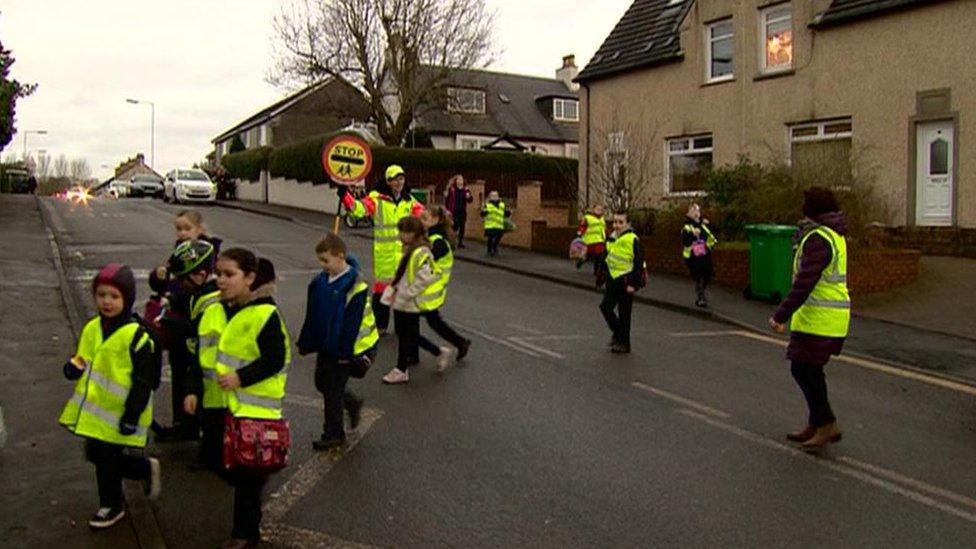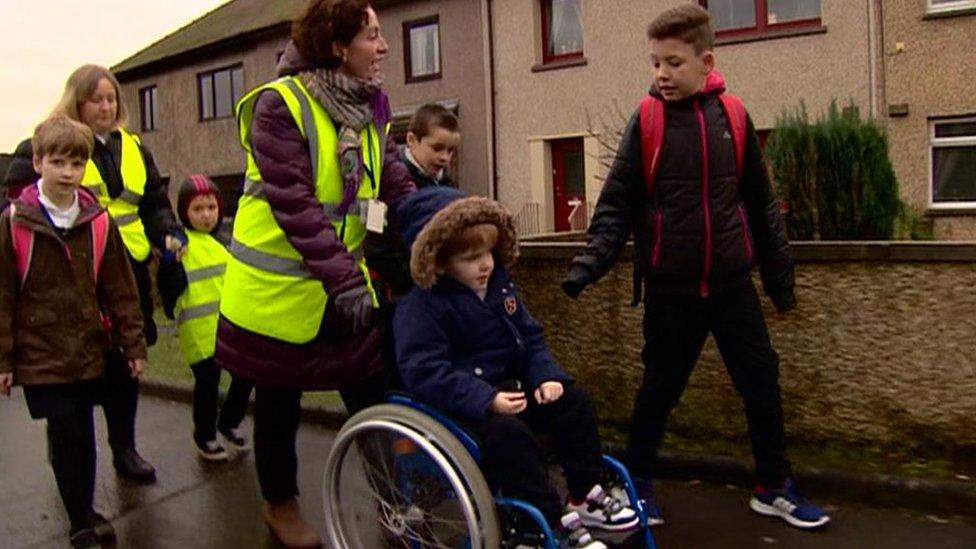School walking bus tackles lateness and absenteeism
- Published
Pupils can join the bus at designated stops along the route
A primary school in Fife has hailed a simple idea as having helped dramatically cut the number of children who arrive late or stay off.
Inzievar Primary in Oakley started up a so-called "walking bus" last year.
Many schools have schemes like this to promote road safety, health and exercise.
But Inzievar, which had relatively high absence levels, tried the idea to see if it might also improve attendance and in turn attainment.
The aim is to encourage children to walk to school together.
The primary's catchment area - in a village near Dunfermline which once housed many miners - includes places which are classed as disadvantaged.

The buses are led by teachers, support staff or parents who have volunteered

Children cross the roads in groups rather than one by one
Head teacher Jane Gray said the success of the initiative - which started last autumn - had vastly exceeded her expectations.
"The data tells us we have gone from an average of 25 children arriving late in a day to 10, sometimes less than that," she said.
"That's a huge improvement. It's not perfect but it's a huge improvement already."
She added: "We had a little boy who was almost never at school and he's here every day. In fact, he's a graduate of the walking bus as he now comes on his scooter."
'Lollipop lady's happy'
Mrs Gray said the initiative had benefited students, parents, teachers and the school's relationship with the local community.
She said: "Teachers can get started in the morning first thing without thinking: am I going to have two or three people coming in late?
"The lollipop lady's happy as she's bringing people across the road in streams rather than in ones and twos. The office staff are delighted as they aren't having to sign so many people in late."
Three "buses" - led by teachers, support staff or parents who have volunteered - now make their way through the village each morning.

Before the bus was introduced Liam, a wheelchair user, had to get a taxi to school
The way the scheme works is simple.
The "bus" starts off in a particular place at a certain time. Like a bus, it goes down particular streets at set times and children can join it at their nearest "stop". As the "journey" goes on, more youngsters join until eventually a big group arrive at school together just before 09:00.
Inzievar is expected to benefit from a government scheme to give £120m straight to head teachers to help raise attainment.
The scheme will give schools across the country around £1,200 for each pupil from P1 to S3 known to be eligible for free school meals.
However, there are few costs associated with starting a walking bus, other than high-visibility vests for safety and producing maps and timetables. Teachers or other responsible adults need to be available to lead the bus and chaperone the children.
Minimal cost
One of the pupils who joins the "bus" regularly is Liam who uses a wheelchair.
Before, he had to get a taxi to school. Now he walks some of the way and the rest of the time other pupils help push his wheelchair.
The idea of "walking school buses" originated in Australia and the first scheme in Britain is thought to have been in St Albans nearly 20 years ago.
The scheme features in a new Education Scotland website for teachers which highlights various initiatives which could help raise attainment.
There may be other schools facing similar challenges to Inzievar which may find that a walking bus scheme works.
Mrs Gray makes the point that the scheme cost little to set up and virtually nothing to run. This means the money they are receiving from the government to help raise attainment can be spent on other projects.